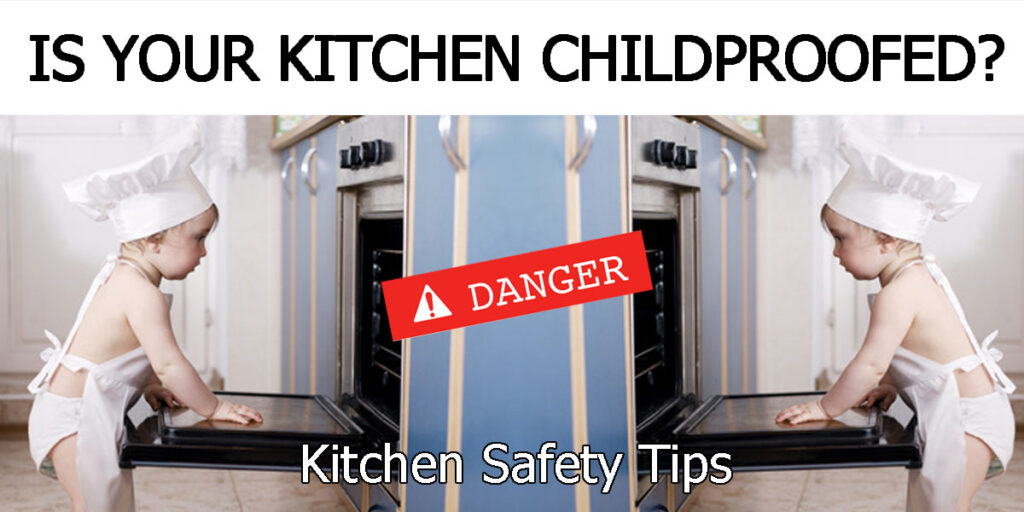
The kitchen is typically the busiest room in the house. It is also the most dangerous and most likely area where a child is at risk for injury. We are all aware of some general ways to child-proof our homes using baby gates, safety latches, plug and knob covers. However, the kitchen has some hidden dangers and needs increased attention to ensure the kids are safe.
The kitchen is also an exciting place for little ones. There are so many interesting and intriguing objects, some shine while others make peculiar noises. Besides, mom/dad spend a lot of time in the kitchen and the kids like to be where the action is.
I have compiled a list of several kitchen concerns for a typical kitchen. However, your individual kitchen area may have other dangers that you should consider. Hopefully, my list will get you thinking, and motivate you to make any necessary changes.
A Recipe For A Safe Kitchen
The Stove – Stoves and ovens have knobs and buttons that look very interesting to the little eye. Things that push or turn appear much like some of the early toys we buy the kids. Children who are learning to stand by pulling themselves up, or those learning to climb are at an increased risk of burns. These tips can help reduce the chance of injury.
- Use the back burners whenever possible
- keep pots and pan handles turned away from the edge of the stove top
- don’t hold your little one while you’re cooking
- turn the burners off if you have to answer the door or take a phone call
- invest in a splatter screen for your frying pans – splattering grease hurts!
- secure your oven door with appropriate appliance latches – children have opened the door, climbed on it and had it tip over on them
The Cabinets – The days of putting the cleaning chemicals under the sink are over. All chemicals that are potentially toxic should be put in a top cabinet and locked. Treat cleaners, soaps and other products as you would medication and vitamins, out of reach even for the best climbers.
- don’t trust containers that have child safety lids – put them up and away
- never put a chemical in a food or beverage container for storage
- if you have wine or liquor in the kitchen get it out of reach and secured
- make sure knifes are in a secure area
- make sure you always close drawers tight – if a toddler pulls on it to stand up the whole drawer may come out
- place less breakable objects at the front of cupboards
- don’t place heavy items in top cupboards – for risk they may fall out on a child
Small Appliances – Today’s kitchens are overflowing with some real neat gadgets. There are “do all” food processors, juicers and even electric whisks. More gadgets mean more chance of injury for little ones in the kitchen. How to store these materials is becoming an ever increasing problem for all of us. Some people leave them lined up on the counter , others in cabinets and I have seen shelving systems in smaller kitchens loaded with these often heavy tools.
- never leave a small appliance plugged in – even the toaster and coffee machine should be unplugged after use
- do not place that heavy crock-pot or bread maker in a high cabinet
- if you have small appliances with removable cords, and you don’t use them on a daily/weekly basis, pack up the cord and store it in another location
- if you have not used an appliance in over a year consider packing it away in the basement or attic or even consider selling it at your next garage sale
The Dishwasher – If you have a front loading dishwasher treat it much like you would your oven door and secure it with appliance latches.
- keep the dishwasher door closed and locked when possible
little children pulling on dishwasher doors can be hit by them and injured - an open dishwasher means that sharp utensils are an easy reach
- never put your dishwasher detergent in the dishwasher until you are ready to start it
- monitor children when the dishwasher is running to ensure it isn’t accidentally opened
The Furniture – Evaluating all of the furniture in your kitchen is the best place to start. Do you have too much furniture? Is the furniture used? What do you need and what could you put away? Furniture that isn’t heavy and secured, can tip causing injury. While furniture that is great to stand on can cause falls.
- use a safety approved stable highchair and remember the safety strap – if your child is attempting to squiggle out then don’t leave them unattended
- don’t leave a step stool in the kitchen area – even if your child isn’t ready to climb and stand on it they could injure themselves by tipping it
- remove all furniture with casters until a little one is secure in getting on and off of chairs and stools – young kids often use furniture for leverage and things with wheels aren’t a safe choice
- forget the table cloths for a few years – young children can easily pull the table cloth off which includes everything that was on top of it
There is also a pinch of common sense required when it comes to kids and kitchens. Putting all these practices in place will make your kitchen area much safer for children. However, the best safety strategy in the kitchen is great supervision. Monitoring kids of all ages is the key to reducing injuries from burns, falls, choking and accidental poisoning.
As the children grow older and wiser they will begin to understand the concept of “danger”. At that time it is important that you educate them about all of the hazards in the kitchen. The more they learn the safer they will be.

Thanks, Deb Rhodes
Look me up on Twitter @ckhomes4sale